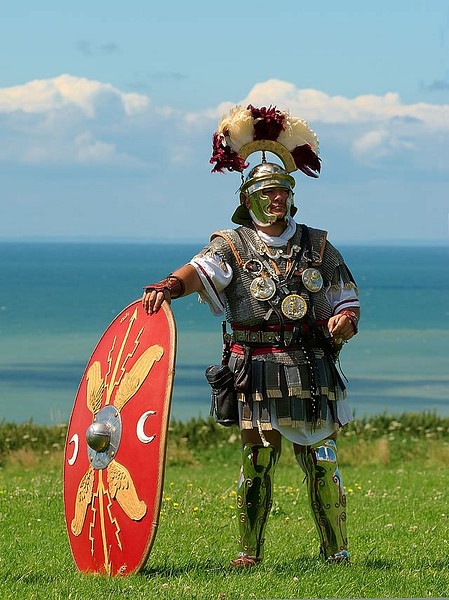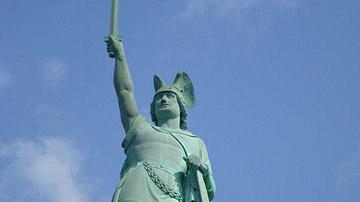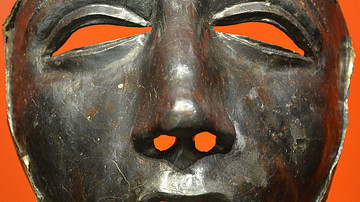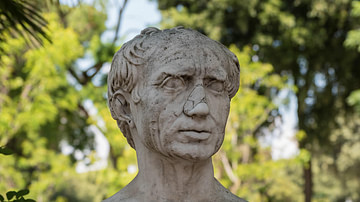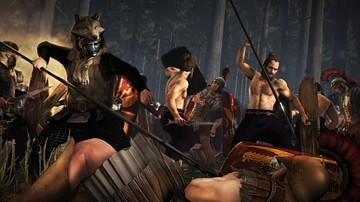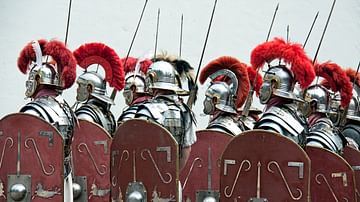
The Roman army, famed for its discipline, organisation, and innovation in both weapons and tactics, allowed Rome to build and defend a huge empire which for centuries would dominate the Mediterranean world and beyond.
Overview
The Roman army, arguably one of the longest surviving and most effective fighting forces in military history, has a rather obscure beginning. The Greek biographer Plutarch credits the fabled founder of Rome, Romulus, with creating the legionary forces (as they would be known in the Republic and Imperial periods), yet the Roman historian Livy says that the early Roman army fought more along the lines of Greek hoplites in a phalanx, most likely as a form of civil militia, with recruitment dependant on a citizen's social standing. King Servius Tullius (c. 580- 530 BCE) introduced six classes of wealth upon Rome's citizens; the lowest group had no property and were excluded from the military, whilst the highest group, the equites, formed the cavalry.
The earliest contemporary account of a Roman legion is by Polybius, and it dates to around 150-120 BCE; this is referred to as the manipular legion, although the manipular legion probably developed around the middle of the 4th century BCE. It is thought that the manipular legion, which was based around smaller units of 120-160 men called maniples (Latin for 'handfuls'), was developed to match the looser formations that Rome's enemies fought in and would be able to outmanoeuvre phalanx formations. The advantage of such a change can be seen when Rome came to fight Macedonia's phalanxes; Polybius 18.29-30 describes the merits of the Roman maniples in being able to outmanoeuvre their enemy.
Livy dates this progression by saying that from 362 BCE Rome had two legions and four legions from 311 BCE. The manipular army was purely citizen at this time, and it would have been the force that saw off Hannibal in the Second Punic War (218- 202 BCE); however, there were more than four legions by then. As the nature of Rome's army changed from limited, seasonal campaigns, and a provincial empire began to come into existence due to the success of such battles as Cynoscephalae (197 BCE) and Pydna (168 BCE), the legions began to develop more permanent bases, in turn creating a manpower shortage.
When Gaius Marius was elected consul in 107 BCE he began to enlist volunteers from citizens without property and equipped them with arms and armour at the expense of the state. The development from the maniple to the cohort is also credited to Marius, though this change may have been finalised by Marius, rather than wholly implemented by him. The Social War of 91- 87 BCE (from the Latin socii allies) highlights that manpower was still a problem for the Roman army, as citizenship was granted to the allied Italians at the end of the war, granting a greater pool of men for the army.

Come the turn of the Republic, and the beginning of Imperial Rome, Augustus reorganised the Roman army, increasing the length of service and creating a military treasury, amongst other things. The army continued to develop, including different tactics and formations that were more effective against Rome's new enemies. By the 2nd century CE Rome was deploying armoured cavalry units, and whilst it had used siege weapons previously, employing arrow and stone-throwing siege-engines, it was in the 3rd century CE that Rome started to notice the use of artillery, with the addition of the onager, a large stone-thrower.
Sources
There are many classical writers who are useful to consult when looking at the Roman army, both Greek and Roman. Polybius is very useful at assessing the Roman Army, providing information on their weapons (6.23), discipline (6.38) and rewards for courage (6.39.1-3; 5-11), as well as describing them in battle. The Jewish historian Josephus (c. 34-100 CE), whilst possibly reusing Polybius, covers the training and discipline of the Roman army (3.71-6; 85-8; 102-7). Frontius (c. 40- 103 CE) wrote a work entitled Stratagems; covered in it is the discipline of Scipio, Corbulo, Piso, and M. Antonius (4.1.1; 4.1.21; 4.1.26; 4.1.37) amongst other issues. Vegetius (c. 5th century CE) wrote an Epitome of Military Science that covers the choosing of suitable recruits, weapons training, training in battle manoeuvres, and other practical issues that relate to the Roman Army.
Recruitment
The citizen soldiers of the manipular army would be enrolled for a specific amount of time, rather than signing up for years of service as they would do in the Imperial period. This meant that the legions of the Roman Republic had no long continual existences because they were disbanded after the campaign they had been serving on was finished. The result of the Marian reforms was a professional standing army for the Roman State, or in the coming years, individual generals who gained the loyalty of their legions.
The majority of Roman soldiers would have been recruited around the age of 18-20 years, and in the 1st century CE, there is a decrease in Italian recruits as recruits from the provinces increased. Conscription into the army probably happened through the cities, since volunteers were not always forthcoming. By this time, whether or not you were a Roman citizen did not matter so much, as long as you were freeborn. This was taken seriously, and as such, a state oath was made as to your freedom:
Trajan to Pliny: "[An officer had discovered two newly enrolled soldiers were slaves]... it needs to be investigated whether they deserve capital punishment. It depends whether they were volunteers or conscripts or given as substitutes. If they are conscripts, the recruiting officer was at fault; if substitutes, those who gave them are to blame; if they presented themselves in full awareness of their own status, that is to be held against them. It is hardly relevant that they have not yet been assigned to units. The day on which they were first approved and took the oath required the truth of their origin from them." Pliny's Letters, (10.30), c. 112 CE.
The army provided little social mobility, and it took a very long time to complete your service; further, you would probably serve abroad, and whilst the pay was not bad, it was nothing special, and many deductions were made from it for food and clothing (RMR, 68, papyrus, Egypt, CE 81 shows so) and there were very harsh disciplinary orders. However, at the same time, the army provided a guaranteed supply of food, doctors, and pay, and it also provided stability. Whilst the pay was not brilliant, it could be supplemented by personal war booty, pay from emperors (normally in their will), also, there was the possibility to progress through the ranks which had clear monetary benefits.
The average centurion got 18 times the pay of the standard soldier, 13,500 denarii, and centurions of the first cohort got 27,000, whilst the primi ordines got 54,000. By the 2nd century CE, there would not have been much active service either, and hence less threat of death, since this was a fairly peaceful time in Rome's history. Because of this later stability and settlement, many army bases incorporated baths and amphitheatres, so the army clearly did have its advantages. However, it was not until Septimius Severus that standard soldiers could legally marry during service (not that this had stopped unofficial marriages beforehand, and furthermore, centurions were allowed to marry beforehand). Likewise, soldiers could also own slaves. Tacitus (Hist. 2.80.5) gives a good example of army living conditions.
Organisation
Whilst Dionysus and Plutarch do not mention the introduction of maniples per se, they do talk of tactical and equipment changes that would be in line with changes that a change to maniples would require. Livy describes how a manipular formation was presented in battle:
…what had before been a phalanx, like the Macedonian phalanxes, came afterwards to be a line of battle formed by maniples, with the rearmost troops drawn up in a number of companies. The first line, or hastati, comprised fifteen maniples, stationed a short distance apart; the maniple had twenty light-armed soldiers, the rest of their number carried oblong shields; moreover those were called “light-armed” who carried only a spear and javelins. This front line in the battle contained the flower of the young men who were growing ripe for service. Behind these came a line of the same number of maniples, made up of men of a more stalwart age; these were called the principes; they carried oblong shields and were the most showily armed of all. This body of thirty maniples they called antepilani, because behind the standards there were again stationed other fifteen companies, each of which had three sections, the first section in every company being known as pilus. The company consisted of three vexilla or “banners”; a single vexillum had sixty soldiers, two centurions, one vexillarius, or colourbearer; the company numbered a hundred and eighty —six men. The first banner led the triarii, veteran soldiers of proven valour; the second banner the rorarii, younger and less distinguished men; the third banner the accensi, who were the least dependable, and were, for that reason, assigned to the rear most line…
(Livy, Ab urbe condita, 8.8)
The standard force of the Roman imperial army was the legions, a heavy infantry, initially composed of Roman citizens, but it was organised very differently to the manipular army. The number of legions in existence at one time often varied, but a rough average is 28. The make-up of each Legion was as follows:
- 10 cohorts to one legion
- six centuries to one cohort
- 10 tents to one century
- eight soldiers to one tent
- 120 cavalry - not really a fighting force, but messengers and scouts.
The Legions were later supplemented by the auxiliaries, who were normally non-citizens, and combined cavalry and infantry. There were four main forms of auxiliary force:
1. Alae quingenariae; one ala of 16 turma; one turma of 30 men; 480 men
2. Infantry cohort; one cohort of six centuries; one century of 80 men; 480 men
3. Cohorts equitates; mixed infantry and cavalry. The auxiliaries were commanded by prefects of the equestrian rank. However, as the auxiliaries developed, a fourth kind of troop was introduced, this reflected the fact the auxiliaries had developed into a status very similar to that of the legionaries.
4. Numeri; from the 2nd century CE onwards, formed from local tribes, around 500 men, they did not have to speak Latin, and often fought in keeping with their local tradition.
When a soldier of the auxiliaries was discharged, he received a military diploma, which granted him and his children Roman citizenship and gave legal acceptance of any marriage; for many, this was a very attractive reward for joining (and surviving) service in the auxiliaries.
The Praetorian Guard was in effect the Roman Emperor's personal bodyguard and consisted of nine cohorts. They were commanded by two Praetorian Prefects of equestrian rank; these men were very powerful. Since they were close to the emperor, they had a unique position for assassination attempts. The Praetorians were primarily recruited from Italy, and it seems likely that they were never conscripted due to the many benefits that they had over regular legionaries. Their service was only for 16 years, and they had better pay than the standard legionary soldier, which, at the end of Augustus' rule, was 225 denarii per year (Tac. Annals, 1.17), Domitian then increased this to 300, Septimus Severus to 450, and Caracalla to 675.
In addition to this, there was the Roman Fleet (classis), the Urban Cohort (3-4 cohorts stationed in Rome that acted as a police force to maintain civil order, under the command of the Urban Prefect), and the Equites Singulares, the cavalry for the Praetorian Guard, which varied in strength from 500-1000 men. In total, for most of the Imperial period, Rome had a military force of around 350,000, taking into consideration there were 28 legions of around 5,500, and then 160,00 divided amongst the auxilia, the troops in Rome, and the fleet.

Ranks
There were various levels of command within the legion. The foremost commander was the Legatus legionis, who was often an ex-praetor. Underneath him came the six military tribunes, made up of one tribunus laticlavius who aided the legate and was second in command and would have been of senatorial rank, and five tribuni augusticlavii of equestrian rank. Then came the praefectus castorum, who dealt with camp logistics and took control if the Legatus legionis and tribunus laticlavius were absent. And then there were the 60 centurions. The centurions had their own rankings, the titles of which are probably based on the organisation of the manipular army. For the 2nd-10th cohorts of a legion, the centurions were ranked, highest to lowest: pilus prior, princeps prior, hastatus prior, pilus posterior, princeps posterior, and the hastatus posterior. For the first cohort, there were five centurions, called the primi ordines, and they were ranked (again, highest to lowest), primus pilus, princeps prior, hastatus prior, princeps posterior, and hastatus posterior.
Equipment, Arms, Armour & Siege Weapons
Our main sources on Roman military equipment come from artistic depictions, military documents, other literature, and surviving archaeological artefacts. The Imperial period presents us with the largest amount of surviving material. The standard weapons of the Roman imperial army were quite similar to those used in the Republic.
The pilum was a heavy spear that was thrown before hand-to-hand combat. Caesar, Gallic War, 1.25 shows how they were employed, and Polybius 6.23. 9-11 how they were constructed. The pilum was thrown in order to kill the enemy but was designed so that if it became stuck in an enemy's shield, it would be a maximum nuisance.
The Republican gladius hispaniensis (Spanish sword) was the other standard weapon of the Roman infantry and was worn on the right hip, being designed for stabbing and thrusting. However, it could also cut, having sharp edges. Livy (31.34.4.) describes the terror of the Macedonian army after seeing the damage that the sword could wreak. The Imperial sword is referred to as the Mainz-type sword (after the location where examples have been found) and is similar. The sword would have been mainly used for stabbing. The Mainz-type then developed into the Pompeii type (examples found at Pompeii and Herculaneum), which had a shorter tip and which may have made it easier to use as a cutting weapon, as well as a stabbing weapon. Both of these swords would have been carried on the right side of the body.
Polybius gives a comprehensive overview of the Republic scutum shield (6.23.2-5), which was circular. Vegetius 2.18 suggests that each cohort had different emblems on their shields and that each soldier would inscribe his name, cohort, and century on the back (much like a modern-day 'dog tag'). However, there does not seem to be any non-contentious material to support Vegetius, and considering his later date, he may be transferring contemporary practises to earlier times. The Imperial scutum differed from the Republican one in that it was rectangular when seen from the front, (this is the stereotypical 'Roman shield'), with a boss in the centre, made of iron or a bronze alloy that was probably used to bash the opponent. Polybius 6.23.14 describes the various types of breast-plate or cuirass that the Republic troops could equip themselves with.
There were three main types of armour employed by the Imperial army; the lorica hamate, iron mail tunics; scale armour, which was made up of metal scales woven onto a cloth base; and the well-known lorica segmentata, which consisted of strips of iron joined by leather straps.
The other major part of a legionary's equipment was his helmet, of which there were many variants, especially early on in Rome's history when soldiers had to provide their own arms. The most typical were made from a single sheet of iron in a bowl shape with a neck guard at the back, a pronounced brow and hinged check guards; all designed to minimise damage and reflect blows made at the wearer's face. The Montefortino style helmet (named after the grave of Montefortino in Ancona where a number of examples were found) was the standard helmet of the 2nd century BCE. Polybius 6.23.12 describes the famous feathered crest of this helmet.
Roman siege weapons tended to be variations or copies of Hellenistic versions; they came in a variety of sizes, shapes, and functions. Most of them are described by Vitruvius X. There were catapults and ballistae (both variations of stone throwers); the smaller Scorpiones, (similar in shape if not design to ballistae) which was an artillery piece, firing bolts; further to this the Romans would employ battering rams and siege towers. Vitruvius passes over the more obvious-to-construct siege ladders. Also, whilst not an actual 'weapon' per se, walls could be undermined by sappers. Josephus, The Jewish War 3. 245-6- describes in quite gory detail the effectiveness of stone throwers. However, siege weapons were also sometimes (but rarely) deployed in open warfare: Tacitus, (Histories 3.23) relates how at the second battle of Bedriacum in 69 CE, where “an exceptionally large catapult… would have inflicted carnage far and wide…” if it were not for two soldiers who snuck up to it and cut its ropes and gears.
Army Camps
It is important to remember what the army would be doing when not fighting in the field; mostly it was training. Route marches might take place three times a month and sometimes manoeuvres would be practised in the field. However, there were civilian duties too. Infrastructures were improved with bridge and road building. Hospitals had to be manned, kilns worked, fuel fetched, and bread baked, to name just a few camp activities. The Vindolanda writing tablets act as a brilliant insight into life at a Roman camp and contain personal letters and camp accounts. Likewise, Josephus, Jewish War, 3. 76- 93, whilst possibly based on Polybius (and therefore not reflecting an overly accurate account for the time in which he was writing), shows the very ordered nature of the Roman army at camp. However, the whole legion need not be based in camp at the same time. Vindolanda Inventory No. 154, of the 1st Tungrian Cohort, shows how the troops were divided across the province, acting as provincial policemen or guards to the governor, to name just two duties outside of the Roman fort that soldiers might be sent to do. The army was a key part of the Roman Empire, and the emperors relied on the army's allegiance; this can be seen by the coin of Vitellius which reads, that he is in power in “agreement with the army”, and by the fact that the emperor was seen as a soldier, and how this was one of the reasons for Nero's failings; Dio Cassius, 69.9, tells of the vital role of the Praetorian guard in Claudius' ascension to power.
Tactics & Formations
Of the maniples, the standard formation of the maniples was triplex acies, with troops drawn up three lines deep, the hastati at the front, the principes in the middle, and the triarii at the back. Each soldier would take up a space around 6 foot square, enabling him to throw his pilum and effectively wield his sword (Pol.18.30.8). The multiple maniples were often spaced a distance equal to their own width away from the next maniple, in a staggered chess board like formation, which has been termed quincunx. Once battles had started it was often up to junior commanders, rather than the general himself, to oversee the motivation of the troops; Plutarch records a unique situation:
The Romans, when they attacked the Macedonian phalanx, were unable to force a passage, and Salvius, the commander of the Pelignians, snatched the standard of his company and hurled it in among the enemy. Then the Pelignians, since among the Italians it is an unnatural and flagrant thing to abandon a standard, rushed on towards the place where it was, and dreadful losses were inflicted and suffered on both sides.
(Plut.Vit.Aem. Paul.1.20)
The Romans also developed many military tactics and methods which would be used for centuries to come, as well as tactics unique to a given situation. When Brutus was besieged by Mark Antony in Mutina, in 43 BCE, the siege was lifted when word got to Brutus about the enemy's plans and actions. Letters were attached to pigeons' necks and they, “longing for light and food, made for the highest buildings and were caught by Brutus.” (Frontinus, Stratagems, 3.13.8). When Quintus Sertorius, an eques of notable military distinction, was outmatched by the enemy cavalry, so “during the night he dug trenches and drew up his forces in front of them. When the cavalry squadrons arrived… he withdrew his line of battle. The cavalry pursued him closely, fell into the ditches, and in this way were defeated.” (Frontinus, 2.12.2). There were also formations against cavalry, Cassius Dio (Roman History, 71.7) describes a defensive formation particularly useful against cavalry: “The Romans… formed into a compact mass so that they faced the enemy at once, and most of them placed their shields on the ground and put one foot on them so that they did not slip so much.” If completely surrounded, this would form a hollow square.
Glorious Victories
Lake Regillus, c. 496 BCE
This semi-legendary battle took place at Lake Regillius between Tusculum and Rome and happened at the very beginning of the Roman Republic. It was fought between Rome and the Latins. The Latins were led by Rome's last and exiled king, Tarquinius Superbus. and this was the king's last attempt to regain power in Rome. The Romans were led by the Dictator Postumius. After much uncertainty on the battlefield, there were three measures which Postumius had to put in place to ensure his victory. Firstly, he ordered his own cohort to treat any fleeing Romans as they would the enemy in order to rally them; then he had to order the cavalry to fight on foot since the infantry were so exhausted; thirdly he provided further incentive to his troops by promising rewards to those who entered the enemy camp first and second. This resulted in such a rush of Roman troops that Tarquinius and the Latins fled the field of battle, and Postumius returned to Rome to celebrate a triumph. Livy, Ab Urbe Condita, 2.19-20, provides a full account of the battle.
Zama, 202 BCE
Zama was the last battle in the Second Punic War and ended 17 years of war between the two states of Rome and Carthage. The Roman legionaries and Italian cavalry (with a supporting body of Numidian cavalry) were led by Publius Cornelius Scipio. The Carthaginians were led by Hannibal, who fielded an army of mercenaries, local citizens, veterans from his battles in Italy, and war elephants. The Roman victory saw an end to Carthaginian resistance, with the Carthaginian senate pressing for peace again. The Romans granted peace, but only at a high price for Carthage.
Infamous Defeats
Lake Trasimene & Cannae, 217 and 216 BCE
The battles of Lake Trasimene and Cannae were two shocking defeats in the Second Punic War at the beginning of Hannibal's entry to Italian lands. Livy, Ab Urbe Condita, 22.4-7 deals with Trasimene and 22.47-8 with Cannae. Cannae was the greatest defeat that the Roman army ever suffered, despite the Romans greatly outnumbering Hannibal's forces (by what exact figure is debated), and the Romans were eventually overcome by what was a pincer movement that entrapped the Romans in the surrounding Carthaginian assembly. Both of these battles saw incredibly fierce fighting. At Lake Trasimene the Romans had been ambushed by Hannibal, and this led to such fierce fighting:
…that an earthquake, violent enough to overthrow large portions of many of the towns of Italy, turn swift streams from their courses, carry the sea up into rivers, and bring down mountains with great landslides, was not even felt by any of the combatants.
(Livy, Ab Urbe Condita, 22.5)
Teutoburg, 9 CE
At the battle of Teutoburg Forest three legions were ambushed and slaughtered by a gathering of Germanic tribes, commanded by Arminius, chief of the Cherusci. The Romans were led by Publius Quinctilius Varus. Tacitus (Annals,1.55-71) describes the scenario and battle in detail but Suetonius, best sums up the effect of this defeat:
“[the defeat] of Varus threatened the security of the empire itself; three legions, with the commander, his lieutenants, and all the auxiliaries, being cut off. Upon receiving intelligence of this disaster, he gave orders for keeping a strict watch over the city, to prevent any public disturbance, and prolonged the appointments of the prefects in the provinces, that the allies might be kept in order by experience of persons to whom they were used. He made a vow to celebrate the great games in honour of Jupiter, Optimus, Maximus, "if he would be pleased to restore the state to more prosperous circumstances." This had formerly been resorted to in the Cimbrian and Marsian wars. In short, we are informed that he was in such consternation at this event, that he let the hair of his head and beard grow for several months, and sometimes knocked his head against the door-post, crying out, " Varus! Give me back my legions!" And ever after he observed the anniversary of this calamity, as a day of sorrow and mourning.
(Suetonius, Augustus, 2)
For the best part of half a millennium, the Roman army acted as the long arm of Roman imperialism over an area of land that encompassed the lands touched and influenced by the Mediterranean. It united Italy, divided Roman allegiances, acting both as the State's enforcer and the enforcer of individuals of power; it was able to subdue German tribes, Carthaginians, Greeks, Macedonians, and many other peoples. It was a force to be reckoned with, and it still is because to understand how the Roman army operated is no easy task, and this definition has only brushed the topsoil off the vast wealth of details on the Roman army that has been buried in time.

